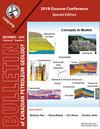阿尔伯塔省下白垩统蓝天组工艺技术分析
Q3 Earth and Planetary Sciences
引用次数: 11
摘要
摘要应用过程技术方法对阿普tian晚期至Albian Bluesky组早期的核心数据集进行了技术分析,以确定古代边缘海洋环境的技术特征。这种方法在识别现代环境中痕量生物对各种物理化学压力的反应方面已被证明是有效的,但它在古代沉积物中的应用还不太成熟。之前对蓝天组的几项研究已经确定了广泛的沉积亲和性;然而,其中很少集中于工艺技术框架内概述的技术标准的详细组合。为了评估工艺技术框架对岩石记录的有效性,记录了高分辨率、系统的工艺特征,并结合了Bluesky组9口含岩心井的沉积学数据。这些特征导致了数据集中几个推断的物理化学应力的识别,显示了从高能量微咸水沉积到低能量海洋环境的整体演变。这项研究有助于建立完善的微咸水技术模型,此外,还有助于建立过程技术方法在识别古代环境中物理化学应力方面的实用性。本文章由计算机程序翻译,如有差异,请以英文原文为准。
Process ichnological analysis of the Lower Cretaceous Bluesky Formation, Alberta
Abstract The process ichnological methodology was applied to a core dataset from the late Aptian to early Albian Bluesky Formation to identify the ichnological characteristics of ancient, marginal marine environments. This methodology has proven effective in recognizing the response of trace making organisms to various physico-chemical stresses in modern environments, but its application to ancient deposits is less established. Several previous studies of the Bluesky Formation have identified a wide range of depositional affinities; however few of these have focused on the detailed combination of ichnologic criteria outlined within the process ichnological framework. In order to assess the effectiveness of the process ichnological framework to the rock record, high resolution, systematic ichnological characteristics were recorded and combined with sedimentologic data from nine wells containing core from within the Bluesky Formation. These characteristics led to the identification of several inferred physico-chemical stresses within the dataset showing an overall evolution from high energy brackish water deposition to a low energy, marine setting. This study contributes to the well-established brackish-water ichnological model and, in addition, helps establish the utility of the process ichnological methodology in the recognition of physico-chemical stresses in ancient environments.
求助全文
通过发布文献求助,成功后即可免费获取论文全文。
去求助
来源期刊

Bullentin of Canadian Petroleum Geology
Earth and Planetary Sciences-Geochemistry and Petrology
CiteScore
2.50
自引率
0.00%
发文量
0
期刊介绍:
The Bulletin of Canadian Petroleum Geology is a peer-reviewed scientific journal published four times a year. Founded in 1953, the BCPG aims to be the journal of record for papers dealing with all aspects of petroleum geology, broadly conceived, with a particularly (though not exclusively) Canadian focus. International submissions are encouraged, especially where a connection can be made to Canadian examples.
 求助内容:
求助内容: 应助结果提醒方式:
应助结果提醒方式:


